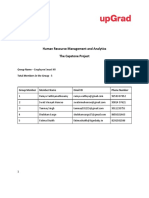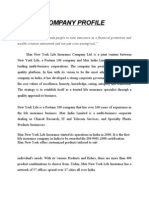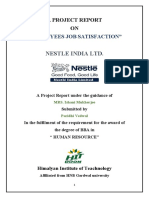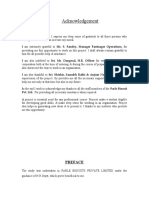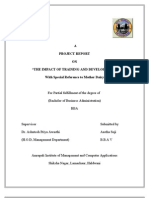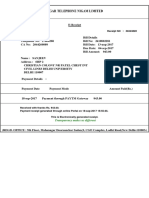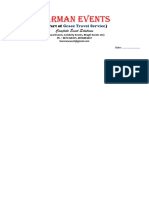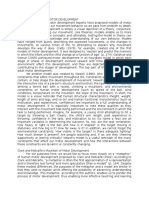Title "Performance Appraisal" in Parle Biscuits Pvt. Limited Problem
Title "Performance Appraisal" in Parle Biscuits Pvt. Limited Problem
Uploaded by
Raman KapoorCopyright:
Available Formats
Title "Performance Appraisal" in Parle Biscuits Pvt. Limited Problem
Title "Performance Appraisal" in Parle Biscuits Pvt. Limited Problem
Uploaded by
Raman KapoorOriginal Title
Copyright
Available Formats
Share this document
Did you find this document useful?
Is this content inappropriate?
Copyright:
Available Formats
Title "Performance Appraisal" in Parle Biscuits Pvt. Limited Problem
Title "Performance Appraisal" in Parle Biscuits Pvt. Limited Problem
Uploaded by
Raman KapoorCopyright:
Available Formats
TITLE PERFORMANCE APPRAISAL IN PARLE BISCUITS PVT.
LIMITED Problem Performance Appraisal has become essential of the very nature of the industrial system. The approach to the problem or movement differs from country to country according to the degree of development in a particular country. Identification of the problem. Appraisal offers a valuable opportunity to focus on work activities and goals, to identify and correct present problems, and to encourage better future performance thus the performance of the whole org. is enhanced. Ethics of PA is such an important factor that it is ignored there arises several problems in organizational issues. Objective The basic objectives of studying the Performance Appraisal measures are: To understand and analyze the performance appraisal system in Parle. To diagnose the strength and weakness of the employees/individuals so as to identify training needs. To develop superior-subordinate relations and thereby reduce grievance. To know how well the employees are doing. Find out the basis for transfer/termination.
To know the scientific basis for reward allocation, wage fixation, raises, incentives, etc. Methdology Research is an original contribution to the existing stock of knowledge for its advancement search of knowledge through objective and systematic method of finding solution to the problem of research. Every project requires genuine research. Success of any project and getting genuine results from that depends upon the research method used by the research. A careful investigation or inquiry especially through search for new facts in any branch of knowledge. This present study makes a sincere effort to know the various employee welfare measures adopted in BILT and also knowing the effectiveness of these measures through evaluating the attitude of employees towards these measures. This chapter deals with the scope, research design, sample design, data collection and limitations of the study.
Company PARLE BISCUITS PVT. LIMITED Profile Parle Products has been India's largest manufacturer of biscuits and confectionery, for almost 80 years. Makers of the world's largest selling biscuit, Parle-G, and a host of other very popular brands, the Parle name symbolizes quality, nutrition and great taste. With a reach spanning even the remotest villages of India, the company has definitely come a very long way since its inception. Many of the Parle products - biscuits or confectioneries, are market leaders in their category and have won acclaim at the Monde Selection, since 1971. With a 40% share of the total biscuit market and a 15% share of the total confectionary market in India, Parle has grown to become a multi-million dollar company. While to consumers it's a beacon of faith and trust, competitors look upon Parle as an example of marketing brilliance. In 1929 a small company by the name of Parle products emerged in British dominated India. The intent was to spread joy and cheer to children and adults alike, all over the country with its sweets and candies. The company knew that it wouldnt be an easy task, but they decided to take the brave step. A small factory was set up in the suburbs of Mumbai, to manufacture sweets and toffees with only 12 employees. They marketed their sweets without having wrappers on them. A decade later it was upgraded to manufacture biscuits as well. The name of Parle biscuits has been derived from the station Vile Parle. Since then, the Parle name has grown in all directions, won international fame and has been sweetening peoples lives all over India and abroad.
Mr. Narottam Lal was known as Technocrat of Parle because he was the first person who learned the process of manufacturing biscuits from England and confectionaries from Germany. Parles production facilities include a flagship plant in Mumbai, Producing biscuits and confectionary; while another factory at Bahadurgarh, Haryana manufactures biscuits, apart from this, Parle has manufacturing facilities at Neemrana, Rajasthan and at Bangalore, Karnataka. The factories at Bahadurgarh and Neemrana are amongst the largest biscuit and confectionary manufacturing facilities in India. In addition, to complement its wholly owned facilities. The company has a further 14 manufacturing units for biscuits; and five units for confectionaries operating under contract. Additionally Parle products also has 7 manufacturing units and 51`manufacturing units on contract. Questionnaire 1. How long, have you been working for parle? 2. What methods the company will follow for appraising performance?
3. After how many time periods your organization is giving you training? 4. Is Training & Development programme effective in Parle ? 5. Who is the head of the Training &Development Programme in Parle? 6. What type of technique is used for training? 7. Do you get any reward for your performance? 8. If, yes, then specify the reward for your performance. 9. What do you prefer for reward for good performance 10. In your opinion what type of action should be taken for bad performance? 11. Do you feel any improvement in your performance due to training programme? 12. If yes, what type of improvement did you find in your performance? RESPONDENT 50 Classify data RESEARCH DESIGN The present study is descriptive cum analytical in nature. A Research Design is the arrangement of conditions for collection and analysis of data in a manner that aims to combine relevance to the research purpose with economy in procedure. Research design is the blue print to study any problem. It is plan for collection, analysis and interpretation of data in a manner that is relevant to the research purpose with economy in the procedure. Exploratory is used for carrying out this research.
Types of Research Design: Research design can be classified into following types: Descriptive & Diagnosis research design Exploratory research design Experimental research design Analytical research design
Exploratory In it the problem is formulated for precise investigation and working hypothesis is developed.
Descriptive & Diagnosis In Descriptive Research Design, those studies are taken which are concerned with describing the characteristics of particular individual or a group. In Diagnostic, those frequencies are determined with which something occurs or its association with something else.
Experimental In it casual relationships between variables are tested. It is also known as Hypothesis Testing Research Design. Analytical In this, researcher has to use facts or information already available and analyses these to make a critical evaluation of the material.
In this project I have used descriptive research design because it describes new ideas and events. It is flexible and can be easily modified in future.
SAMPLING DESIGN:
A sample design is a definite plan for obtaining a sample from a sample from a given population. There are many sample designs from which a researcher can choose. Researchers must prepare/select a sample design which should be reliable and appropriate for his research only. It is very different to interview all the employees.
Universe of Study
The universe of study is confined to Parle Company, operating in a particular region of Bahadurgarh in Haryana SAMPLE
Sample Size
20 Top Level
30 Middle Level 10 Operative Level
SAMPLING METHOD Qualitative technique used: Percentile Method
COLLECTION OF DATA
Validity of research program depends upon the quality of data that is collected and the tools that have been employed.
Primary Data
Questionnaire Questionnaire had to be filled from the employees and from the rater so that analysis can be made out of it.
Personal Interview Major data had to be collected from the staff members of the company so a personnel interview was the demand of the project.
Secondary Data
Major data refers to the data which have been collected and analyzed by some one else. Tools used for secondary data was: Internet Newspaper Data provided by the company
In this study we used primary data.
Reference Rao V. S. P., Human Resource Management, Vikash Parkashan, 4th Edition, 1995 Aswathappa K, Human Resource & Personnel Management, New Delhi, Himalaya Publishing House, 3rd Edition 1990 Kothari C.R., Research methodology Methods & Techniques, Wishwa Prakasan, 3rd revised edition, 2005 Deshpande, Milind V., TQM & ISO, Punew, Symbiosis Centre for Distance Learning, April, 2002. Aswathappa. K., Organizational Behaviour, New Delhi, Himalaya Publishing House, 2002. WEBSITES www.parleproducts.com www.parle.biz.com www.google.com www.yahoo.com
Chapter 1. Introduction 2. Significances 3. Objectives of the Study 4. Research Methodology 5. Data Analysis & Interpretation 6. Findings 7. Recommendation and Suggestion 8. Conclusions 9. Limitations BIBLIOGRAPHY ANNEXURE
You might also like
- IIMK HRMA - Capstone Project Report PDFDocument24 pagesIIMK HRMA - Capstone Project Report PDFRamya Vaithya100% (4)
- Recruitmment & Selection of Reddys LabDocument84 pagesRecruitmment & Selection of Reddys Labsathulurisambashiva100% (1)
- Projet TomDocument47 pagesProjet TomTom Thomas100% (1)
- Blackbook Project On Employee MotivationDocument63 pagesBlackbook Project On Employee MotivationAtharva Rajpurkar50% (4)
- A Project Report On "Marketing Strategies of LAKME": Chaudhary Charan Singh University, MeerutDocument75 pagesA Project Report On "Marketing Strategies of LAKME": Chaudhary Charan Singh University, MeerutRishu Lour75% (4)
- Summer Training Report111Document54 pagesSummer Training Report111Adewitiya Singh0% (1)
- Sahara Scam by ArchitaDocument18 pagesSahara Scam by ArchitaRaman Kapoor100% (1)
- María Blume, Barbara C. Lust Research Methods in Language Acquisition Principles, Procedures, and PracticesDocument307 pagesMaría Blume, Barbara C. Lust Research Methods in Language Acquisition Principles, Procedures, and PracticesJosé Oneris DissenhaNo ratings yet
- Effects of Gadgets Under Modular Learning To The Academic Performance of The StudentsDocument74 pagesEffects of Gadgets Under Modular Learning To The Academic Performance of The Studentsjas luuemin77% (30)
- Certificate ProjectDocument32 pagesCertificate ProjectBhumika BangaNo ratings yet
- Aavin ProjectDocument42 pagesAavin ProjectlittlemagicpkNo ratings yet
- Training and Learning Development Is An Essential Part in The Successful Organization, ASDA?Document8 pagesTraining and Learning Development Is An Essential Part in The Successful Organization, ASDA?Ye LayNo ratings yet
- Copy (2) of Project ReportDocument106 pagesCopy (2) of Project ReportPrafulla Tekriwal60% (5)
- Cocacola T&DDocument68 pagesCocacola T&DKIRAN KUMAR MADDINENINo ratings yet
- Parle ReportDocument65 pagesParle Reportnetishrai88100% (2)
- Index: S. R. No. 1Document10 pagesIndex: S. R. No. 1Ruchi KapoorNo ratings yet
- Galla FoodsDocument81 pagesGalla FoodsManoj Kumar100% (3)
- Deepak ProjectDocument62 pagesDeepak Projectdeepak singhNo ratings yet
- Synopsis of PEPSICO (1) UpdatedDocument11 pagesSynopsis of PEPSICO (1) UpdatedSanskar DhabekarNo ratings yet
- Chapter-1: Objective of Study Scope of Study Research Methodology Limitation of StudyDocument31 pagesChapter-1: Objective of Study Scope of Study Research Methodology Limitation of StudyS SssNo ratings yet
- Millennium Institute of Management: Maulana Azad Educational Trust'sDocument60 pagesMillennium Institute of Management: Maulana Azad Educational Trust'sTravis RichardNo ratings yet
- Microsoft Word - Project On Quot Employee Loyalty in Tata Motors QuotDocument63 pagesMicrosoft Word - Project On Quot Employee Loyalty in Tata Motors QuotnehaNo ratings yet
- Training and Development at IglDocument86 pagesTraining and Development at Iglvkumar_345287No ratings yet
- Conversion Gate02Document69 pagesConversion Gate02shubhamNo ratings yet
- Study On LakmeDocument27 pagesStudy On LakmekunalNo ratings yet
- Employee Satisfaction With HR Policies at EsocrtsDocument94 pagesEmployee Satisfaction With HR Policies at EsocrtsNisha AggarwalNo ratings yet
- Prithvi 14decDocument64 pagesPrithvi 14decmohammad aayaanNo ratings yet
- Project ReportDocument61 pagesProject Reportdeepak singhNo ratings yet
- Project MaricoDocument23 pagesProject Maricoharishma29100% (1)
- Pranay JunghariDocument42 pagesPranay JunghariPranjali JungariNo ratings yet
- Malabar CementsDocument73 pagesMalabar CementsJino Joy100% (3)
- Project On HRDocument131 pagesProject On HRGajendra Singh Raghav100% (1)
- Jio Dissertation MBA IIDocument39 pagesJio Dissertation MBA IIHarish GujareNo ratings yet
- A Minor Project Report On "A Study of Marketing Strategies of LAKME"Document71 pagesA Minor Project Report On "A Study of Marketing Strategies of LAKME"Piyush Goyal100% (2)
- Company Profile2Document13 pagesCompany Profile2aaryan698No ratings yet
- Ajarul SK (Synopsis)Document7 pagesAjarul SK (Synopsis)udit BarmanNo ratings yet
- Project ReportDocument63 pagesProject Reportdeepak singhNo ratings yet
- Archana Chauhan ProjectDocument49 pagesArchana Chauhan ProjectGourishankar SharmaNo ratings yet
- CHAPTER 3 Trainind andDocument3 pagesCHAPTER 3 Trainind andChandan ChanduNo ratings yet
- Nestle SynopsisDocument19 pagesNestle SynopsisanitikaNo ratings yet
- Paridhi Vedwal BBA 6th SemDocument96 pagesParidhi Vedwal BBA 6th SemParidhi VedwalNo ratings yet
- Effectiveness of T D For Future Group EmployeesDocument64 pagesEffectiveness of T D For Future Group EmployeesPratikshya SahooNo ratings yet
- ADDDDDocument56 pagesADDDDDiwakar singhNo ratings yet
- 2003Document51 pages2003Aditi AgarwalNo ratings yet
- Certificate: This Is To Certify That MAHERA MEHMOOD Assigned The Research Project OnDocument126 pagesCertificate: This Is To Certify That MAHERA MEHMOOD Assigned The Research Project OnAshutoshSharmaNo ratings yet
- Documents - Pub - Performance Appraisa ParleDocument84 pagesDocuments - Pub - Performance Appraisa Parleshital madhavrao ghayalNo ratings yet
- HR SoneeDocument78 pagesHR SoneeSATISH KUMARNo ratings yet
- Project On Employee Attrition AnupamaDocument6 pagesProject On Employee Attrition AnupamaIshank GuptaNo ratings yet
- Final AkashDocument62 pagesFinal AkashAmar RajputNo ratings yet
- Impact of Promotional Activities For Selling HCL ProductsDocument49 pagesImpact of Promotional Activities For Selling HCL ProductsAMIT K SINGHNo ratings yet
- Brand Management in Service IndusryDocument43 pagesBrand Management in Service Indusryakshayjyani001No ratings yet
- Human Resource ManagementDocument12 pagesHuman Resource ManagementAnonymous wnSH9rt6dENo ratings yet
- Final RDocument77 pagesFinal RJayesh BhansaliNo ratings yet
- Impact of Promotional Activities For Selling HCL Products by Arun SutharDocument47 pagesImpact of Promotional Activities For Selling HCL Products by Arun SutharShezad Khan0% (1)
- Training and Development in IncapDocument83 pagesTraining and Development in Incaptulasinad1230% (2)
- Training ProgramDocument71 pagesTraining Programashim080750% (2)
- Synopsis Report - Raja Rocky SinghDocument23 pagesSynopsis Report - Raja Rocky Singhraja rockyNo ratings yet
- Training and DevelopmentDocument62 pagesTraining and Developmentsanjayduttpandey3067% (3)
- UntitledDocument70 pagesUntitledzynulabidNo ratings yet
- "A Study On Employees Welfare at Infolink Private LTD": Summer Internship ProjectDocument41 pages"A Study On Employees Welfare at Infolink Private LTD": Summer Internship Projectnidhibhatt406No ratings yet
- Sustaining Creativity and Innovation in Organizations: a Tool Kit: Employee Suggestion SystemFrom EverandSustaining Creativity and Innovation in Organizations: a Tool Kit: Employee Suggestion SystemNo ratings yet
- Measuring ROI in Learning & Development: Case Studies from Global OrganizationsFrom EverandMeasuring ROI in Learning & Development: Case Studies from Global OrganizationsNo ratings yet
- Designing Training to Shorten Time to Proficiency: Online, Classroom and On-the-job Learning Strategies from ResearchFrom EverandDesigning Training to Shorten Time to Proficiency: Online, Classroom and On-the-job Learning Strategies from ResearchNo ratings yet
- AOL Part 1 FormDocument1 pageAOL Part 1 FormRaman KapoorNo ratings yet
- InterviewDocument2 pagesInterviewRaman KapoorNo ratings yet
- Financial Statement Analysis & Business Valuation of NTPC Vidyut Vyapar Nigam LTDDocument11 pagesFinancial Statement Analysis & Business Valuation of NTPC Vidyut Vyapar Nigam LTDRaman KapoorNo ratings yet
- Deepak Enterprises: Rubber BandsDocument2 pagesDeepak Enterprises: Rubber BandsRaman KapoorNo ratings yet
- Declaration of OriginalityDocument1 pageDeclaration of OriginalityRaman Kapoor100% (1)
- Common Induction MootDocument1 pageCommon Induction MootRaman KapoorNo ratings yet
- Common Induction MootDocument1 pageCommon Induction MootRaman KapoorNo ratings yet
- Nit 1Document257 pagesNit 1Raman KapoorNo ratings yet
- Guidelines For Summer Training Report PDFDocument10 pagesGuidelines For Summer Training Report PDFRaman KapoorNo ratings yet
- Alka Kapoor: ABFS New Employee InductionDocument1 pageAlka Kapoor: ABFS New Employee InductionRaman KapoorNo ratings yet
- Display MSG Pay TMDocument1 pageDisplay MSG Pay TMRaman KapoorNo ratings yet
- FORM NO.: 2017/290: Subject: Shubham BansalDocument6 pagesFORM NO.: 2017/290: Subject: Shubham BansalRaman KapoorNo ratings yet
- Certificate FinallDocument7 pagesCertificate FinallRaman KapoorNo ratings yet
- Common Induction MootDocument1 pageCommon Induction MootRaman KapoorNo ratings yet
- Harman Events: Complete Event SolutionsDocument1 pageHarman Events: Complete Event SolutionsRaman KapoorNo ratings yet
- S.no - Medicine Week1 Week2 Week3 Week4 Week5 Week6 Week7 Week8 1 AugmentinDocument1 pageS.no - Medicine Week1 Week2 Week3 Week4 Week5 Week6 Week7 Week8 1 AugmentinRaman KapoorNo ratings yet
- Guidelines For Summer Training Report PDFDocument10 pagesGuidelines For Summer Training Report PDFRaman KapoorNo ratings yet
- Receipt NO: 5096802653: Transparency Makes Us DifferentDocument1 pageReceipt NO: 5096802653: Transparency Makes Us DifferentRaman KapoorNo ratings yet
- Table of Content Part - 1: 8 10 CHAPTER 3 OBJECTIVES ... 12 13 14 17 19Document2 pagesTable of Content Part - 1: 8 10 CHAPTER 3 OBJECTIVES ... 12 13 14 17 19Raman KapoorNo ratings yet
- Coffee Table Book1mamDocument54 pagesCoffee Table Book1mamRaman KapoorNo ratings yet
- Services, N3.2-L1, L7 To L10 at Tower-2, Infospace Park, Plot No.2, Block-B, Sector-62, Noida. It Is Intended To Give The Basic Principles ofDocument2 pagesServices, N3.2-L1, L7 To L10 at Tower-2, Infospace Park, Plot No.2, Block-B, Sector-62, Noida. It Is Intended To Give The Basic Principles ofRaman KapoorNo ratings yet
- GroupDocument1 pageGroupRaman KapoorNo ratings yet
- Intial Pages PGDGCDocument4 pagesIntial Pages PGDGCRaman KapoorNo ratings yet
- Intial Pages PGDGCDocument4 pagesIntial Pages PGDGCRaman Kapoor100% (1)
- Letter Head Indian SpicesDocument1 pageLetter Head Indian SpicesRaman KapoorNo ratings yet
- Cover Letter: Application For InternshipDocument2 pagesCover Letter: Application For InternshipRaman KapoorNo ratings yet
- DeclarationDocument10 pagesDeclarationRaman KapoorNo ratings yet
- Background of The StudyDocument3 pagesBackground of The StudyRaman KapoorNo ratings yet
- Tirupati Stracturals Limited: Industerial Training ReportDocument1 pageTirupati Stracturals Limited: Industerial Training ReportRaman KapoorNo ratings yet
- A Study To Assess The Knowledge of Mothers Regarding Weaning Among Children 6 Months To 2 Years of Age in Selected Rural Areas of Punjab India PDFDocument3 pagesA Study To Assess The Knowledge of Mothers Regarding Weaning Among Children 6 Months To 2 Years of Age in Selected Rural Areas of Punjab India PDFPriyanjali SainiNo ratings yet
- Digging - Up The Concepts and Principles of Practical Research 2Document147 pagesDigging - Up The Concepts and Principles of Practical Research 2Santo Tomas Mio100% (1)
- An Exploratory Study To Assess The Knowledge Among Mothers of Under Five Children Regarding Thumb Sucking in Selected Village of MogaDocument58 pagesAn Exploratory Study To Assess The Knowledge Among Mothers of Under Five Children Regarding Thumb Sucking in Selected Village of MogaVarun JainNo ratings yet
- Classification of Research DesignDocument15 pagesClassification of Research DesignArihantAskiGoswami100% (5)
- Eloisa Anne Del Rosario: REPORTER: Jhea Mae CudiamatDocument33 pagesEloisa Anne Del Rosario: REPORTER: Jhea Mae CudiamatDaniel GrangerNo ratings yet
- MKT 426 Course Syllabus Summer 2020Document16 pagesMKT 426 Course Syllabus Summer 2020Julficar JacariaNo ratings yet
- Sample Research ReportDocument38 pagesSample Research Reportmarynille joy dela cruzNo ratings yet
- Advanced Composition and Initiation To Research - S4 - G3 - ZaidDocument31 pagesAdvanced Composition and Initiation To Research - S4 - G3 - ZaidKai KokoroNo ratings yet
- A Learners Guide To The Cambridge Research Report PDFDocument100 pagesA Learners Guide To The Cambridge Research Report PDFRomina Farina100% (1)
- Research Tracking StudyDocument46 pagesResearch Tracking Studyjicster123No ratings yet
- BRM Question Bank 2019 Q.1. (2 5 10) Solve Any Five QuestionsDocument4 pagesBRM Question Bank 2019 Q.1. (2 5 10) Solve Any Five Questionsvenkatesh telang100% (1)
- Models of Lifespan Motor DevelopmentDocument16 pagesModels of Lifespan Motor DevelopmentAbdullah Al-HazmyNo ratings yet
- Project Report Primary Market Investors Views PDFDocument14 pagesProject Report Primary Market Investors Views PDFDines Kumar0% (1)
- A Study On Customer Satisfaction On BhatDocument10 pagesA Study On Customer Satisfaction On BhatSanjip ShresthaNo ratings yet
- Koutons RetailDocument36 pagesKoutons Retailj_sachin09No ratings yet
- Ch01 51 TotalDocument1,131 pagesCh01 51 TotalLinda RosalinaNo ratings yet
- Module 2Document54 pagesModule 2Arun P PrasadNo ratings yet
- Vision Syndrome Pada Unit Refinery Central Control Room: Identifikasi Interaksi Manusia Dan Komputer Berbasis ComputerDocument10 pagesVision Syndrome Pada Unit Refinery Central Control Room: Identifikasi Interaksi Manusia Dan Komputer Berbasis ComputerWiwaha De AngeloNo ratings yet
- MKTG 342-Marketing Research-Farrah ArifDocument6 pagesMKTG 342-Marketing Research-Farrah ArifHaris AliNo ratings yet
- Course OutlineDocument2 pagesCourse OutlineDagim AbaNo ratings yet
- SCM Project On Blue DartDocument82 pagesSCM Project On Blue Darttaufik pathan0% (3)
- Ola and UberDocument37 pagesOla and UberAkshay Chhablani0% (1)
- Lived in Experience of Patients Subjected To Cataract SurgeryDocument25 pagesLived in Experience of Patients Subjected To Cataract Surgeryshoba0880100% (1)
- Validity Issue in Mixed Reserch PDFDocument16 pagesValidity Issue in Mixed Reserch PDFRanjani C NarayanNo ratings yet
- Jurnal Bahasa InggrisDocument3 pagesJurnal Bahasa InggrisJenny MaulidyaNo ratings yet
- A Study On The Level of Consumer Satisfaction WithDocument61 pagesA Study On The Level of Consumer Satisfaction Withmit=aishNo ratings yet
- Eating HabitsDocument46 pagesEating HabitsAaliyah ManuelNo ratings yet
- Designing Research Concepts, Hypotheses, and MeasurementDocument32 pagesDesigning Research Concepts, Hypotheses, and MeasurementAngel UrbanoNo ratings yet
